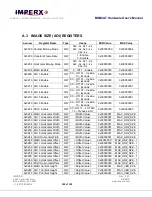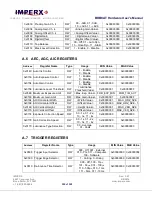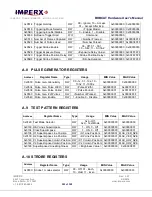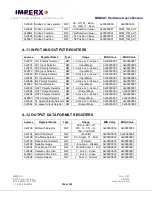
CAMERAS FRAME GRABBERS IMAGING SOLUTIONS
BOBCAT Hardware User’s Manual
IMPERX
Rev. 2.0.7
6421 Congress Ave.
4/8/2014
Boca Raton, FL 33487
www.imperx.com
+1 (561) 989-0006
311 of 329
C.1
OVERVIEW
The Defective Pixel Map (DPM) and Hot Pixel Map (HPM) are provided with each camera. If the
user wants to create its own DPM or HPM file, he/she can use any standard ASCII text editor or
Microsoft Excel. Additionally, any spreadsheet or mathematical program capable of generating a
comma delimited (.csv) file can be used.
C.2
USING AN ASCII TEXT EDITOR
A custom Defective Pixel Map (DPM) and Hot Pixel Map (HPM) can be prepared using any
ASCII text editor, such as “Notepad” or similar. The file must have a .dpm extension for DPM
map and .hpm extension for HPM. The .dpm (or .hpm) file has two main sections: a header and a
table. The ‘header’ section is a free text area of up to 256 ASCII characters. Each line of the header
section must be terminated in a comma. The ‘table’ section of the file contains an array of lines
with each line containing an X (pixel number) value followed by a comma and a Y (line number)
value. All pixels are listed in the DPM (or HPM) in order of increasing Y location. If the Y
location is identical, the listing is in order of increasing X location. After editing save each file
with the appropriate file extension. The maximum number of pixels in the DMP list is 128, and in
HPM list is 1024.
Here is a simple example how to create a DPM. Create the DPM file with extension .dpm using
“Notepad” or any other editing software. Locate the defective pixels in the camera and enter them
in order starting with the smallest pixel number of the line number first. The file looks like this:
-- Defective Pixel Map,
-- Date: 7/21/2013,
-- Model#: CLB-B0610M,
-- Serial#: 060380,
:Table,
-- Column(X),Row(Y)
4,1
588,1
78,5
82,27
405,300
Note.
In this example the first table entry is pixel 4 from line 1, the next entry is pixel 588 from line 1,
and the next entry is pixel 78 from line 5 and so on.
















































